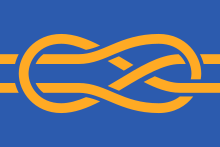Vexillology
Vexillology is the study of flags. The word comes from both the Latin word vexilla "little sail" for flag plus the Greek suffix-ology that means "study of". The vexillum was a particular kind of flag used by the Roman legions. Vexillology is a kind of study of symbols related to heraldry. A person who studies flags is a vexillologist, and a person who designs flags is a vexillographer.

Because they are flown outside, where they move with the wind, flags are usually designed with bold images and bright, basic colors. Flag design also follows a historical process, where later flag designs are based on earlier flag designs. This means that many flags in an area may look similar because they are all based on one historical flag. Examples include the Pan-African colors, Pan-Arab colors, and the Nordic Cross.
Flag Identification System (FIS)
The Flag Identification System was created by Whitney Smith and adopted by Fédération internationale des associations vexillologiques (FIAV).
The first row is for use on land and the second row is for use on water, each divided into private (civil), government (state), and military (war) use.
| Usage | Private Use | Government Use | Military Use |
|---|---|---|---|
| Land Use | Civil Flag | State Flag | War Flag |
| Sea Use | Civil Ensign | State Ensign | War Ensign |
There are 63 symbols that can describe the flag, including:
Other symbols are used to describe other uses of the flag, such as official status and which side of the flag is shown. The symbols in common use are:
 Normal or de jure version of flag, or obverse (front) side
Normal or de jure version of flag, or obverse (front) side Design proposed but not officially adopted
Design proposed but not officially adopted Design is a reconstruction
Design is a reconstruction Reverse (back) side of flag
Reverse (back) side of flag Design is a variant (a different form of the same flag)
Design is a variant (a different form of the same flag) Alternative (different) version of flag
Alternative (different) version of flag De facto (unofficial but in actual use) version of flag
De facto (unofficial but in actual use) version of flag Flag has different designs on its front and back
Flag has different designs on its front and back Obverse (front) side meant to be hoisted (raised) with pole on the right
Obverse (front) side meant to be hoisted (raised) with pole on the right Design approved by the government to represent a nation
Design approved by the government to represent a nation Design used in the past, but now abandoned (This symbol was not part of Smith's original set.)
Design used in the past, but now abandoned (This symbol was not part of Smith's original set.) Reverse side is mirror image of obverse side
Reverse side is mirror image of obverse side Reverse side is the obverse side flipped
Reverse side is the obverse side flipped Information about the reverse side is not known
Information about the reverse side is not known Flag can be hung vertically by hoisting on a normal pole and then turning the pole 90°
Flag can be hung vertically by hoisting on a normal pole and then turning the pole 90° Flag can be hung vertically by rotating the design first
Flag can be hung vertically by rotating the design first Vertical hoist method is unknown
Vertical hoist method is unknown Design has no element that can be rotated
Design has no element that can be rotated Flag can only be hoisted vertically
Flag can only be hoisted vertically





























